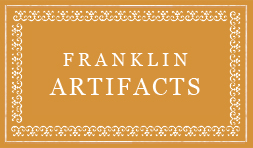
Hosted and administered by the Phillips Museum of Art at Franklin & Marshall College, the Franklin Artifacts database is a museum without walls; an electronic catalogue of known surviving objects with a close association to Benjamin Franklin. Entries include images of him that were created during his lifetime; artifacts he is believed to have bought, owned, been given, or gave away; and memorial objects created around his death.
Recorded here are over 300 objects, representing 90 public and private collections around the United States and Europe, including over 100 of the objects that were part of the exhibition “Benjamin Franklin: In Search of a Better World.”
Whenever possible, the entries include a description, an image, a history of ownership (provenance), and reference to publications in which the object is cited. Commentary on the object’s condition may be included, as may links to related objects and people.
Decisions were made to restrict or eliminate categories of objects, usually because of the numbers of surviving examples, e.g., currency from Franklin’s press. Books printed/owned by Franklin are covered in other references. Most works produced in multiples (such as engraved portraits) are represented by a single entry, which may include mention of museum collections where they can be seen. Yale University’s extraordinary series of volumes of Franklin Papers can be found here.
Users will find frequent references to several volumes, most published over the past half century. Without those precursors, the project would have been far more difficult. The most significant of them, Charles Coleman Sellers’ Benjamin Franklin in Portraiture (1962), is monumental in its scope. In addition, the continuing advice and cooperation of professional associates has been essential to the database’s production, and is acknowledged with sincere thanks.
It is essential to remind users that the images included the database are for reference only, and may not be republished without specific permission from the owner of the item.
Perhaps the most significant fact about the Franklin Artifacts database is its lifespan: the database will continue to grow as new information is gathered about existing artifacts, and new images and new artifacts are located. It is like a museum whose collections can expand without the need to build new galleries.
Constance V. Hershey
Founding Curator, Franklin Artifacts database